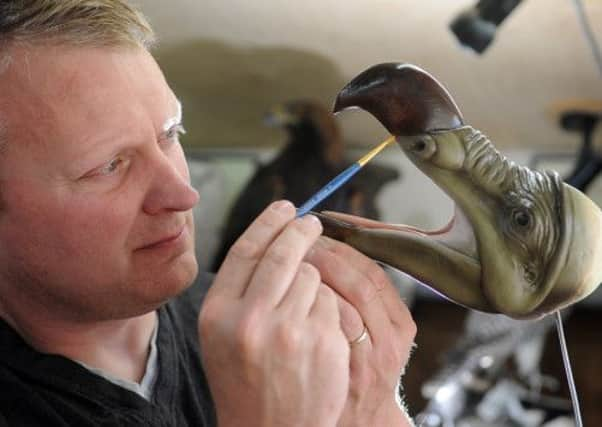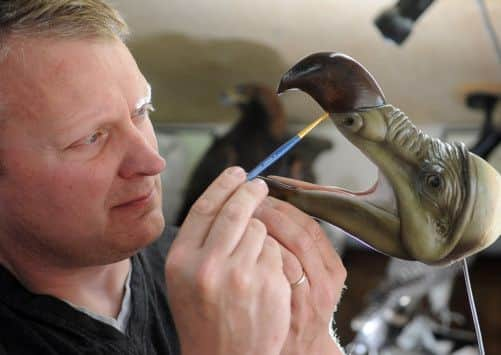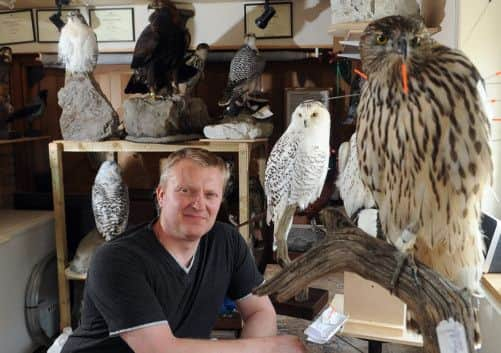Dodo video: Stuff of dreams as world’s biggest collection takes flight


The Great Dodo Exhibition at Kendal Museum is a collection of lifelike reproductions of the flightless bird which scientists understand became extinct in the 17th century. It features various adult dodos in lifelike poses, a dodo chick, a dead hanging dodo, a dodo skeleton assembled from bones from three separate dodos, alongside bones from birds of a similar size. A dodo bone loaned by The Last Tuesday Society in London will also be on display.
The exhibition will be the world premiere of the dodos being exhibited together.
Advertisement
Hide AdAdvertisement
Hide AdExtinct since the late 17th century, the dodo was a flightless forest-dwelling bird of Mauritius. Pickering based taxidermist Carl Church has been producing ‘recitation dodos’ for some time and has attracted a number of buyers for his artwork. His models, created by a process that involves sculpting, moulding and casting, are among the headline artefacts at Kendal Museum.


It is a proud achievement for Carl, 43, originally from Ackworth near Pontefract, who took up taxidermy in his 20s. He now works full-time from a fully equipped workshop specialising in birds of prey.
“It’s what I always wanted to do as a kid and when I left school,” he said.
“I’ve done numerous jobs from working on a farm milking cows to being a coded welder and labouring on building sites and then I got a job at Castleford so I spent a lot of hours on the A64 travelling from Pickering. I saw a lot of birds that had been killed in the traffic and from there I decided to start a collection of birds myself. I got hold of some books on taxidermy and joined the Guild of Taxidermists. I thought it was such a hidden art.”
Advertisement
Hide AdAdvertisement
Hide AdHe launched a website in eight years ago to reach interested collectors outside of his local area and his clients include collectors across Europe.


His attempts at recreating the dodo started out as something of a side project but his finished efforts have attracted buyers, including a recent sale to Roland Mouret, the Mayfair clothes designer. Carl uses turkey skins to cover the dodo models with feathers.
“My emblem’s a dodo because it’s one of the most iconic birds and easy for people to remember me by.
“Someone said to me once you’ll never get one of them so I decided to make one myself.
Advertisement
Hide AdAdvertisement
Hide Ad“I made the first one and it went into a private collection and onto Kendal Museum. The second one was on TV on Big Ask and then went into another private collection. Then I decided to make a lot of them and see if they would sell but the turkeys I use aren’t readily available so I have to get someone to breed a specific colour of turkey.”
His customers tend to be of a certain profile.
“In the 60s and 70s, instead of playing the PlayStation young men would play out and collect bones and skulls from fields. These are the people who collect taxidermy. My youngest collector is 59.”
Carl’s birds have won awards at the World Taxidermy Show in Illinois, USA, but he is aware that not everyone appreciates the appeal of his profession.
“Some people still look at these birds and see dead animals and they are dead animals but that’s the medium I work with. I don’t see them die like a builder doesn’t see the wood he uses chopped down, it’s just the medium I work with.”
Advertisement
Hide AdAdvertisement
Hide AdCarl gives talks about his work, usually to taxidermists and artists, but he recalls one engagement in particular, at the Baltic Centre, Newcastle, where he suddenly felt far removed from his comfort zone.
“It wasn’t until I had completely set up that I realised I wasn’t in front of taxidermists and country people like I’m used to. I was smack bang in the middle of a city in front of town people, but they were really good in the end.”
With the age profile of his customers growing in seniority by the year, Carl has plans to branch out into wood carvings of birds of prey which he hopes will appeal to a younger generation of collectors.